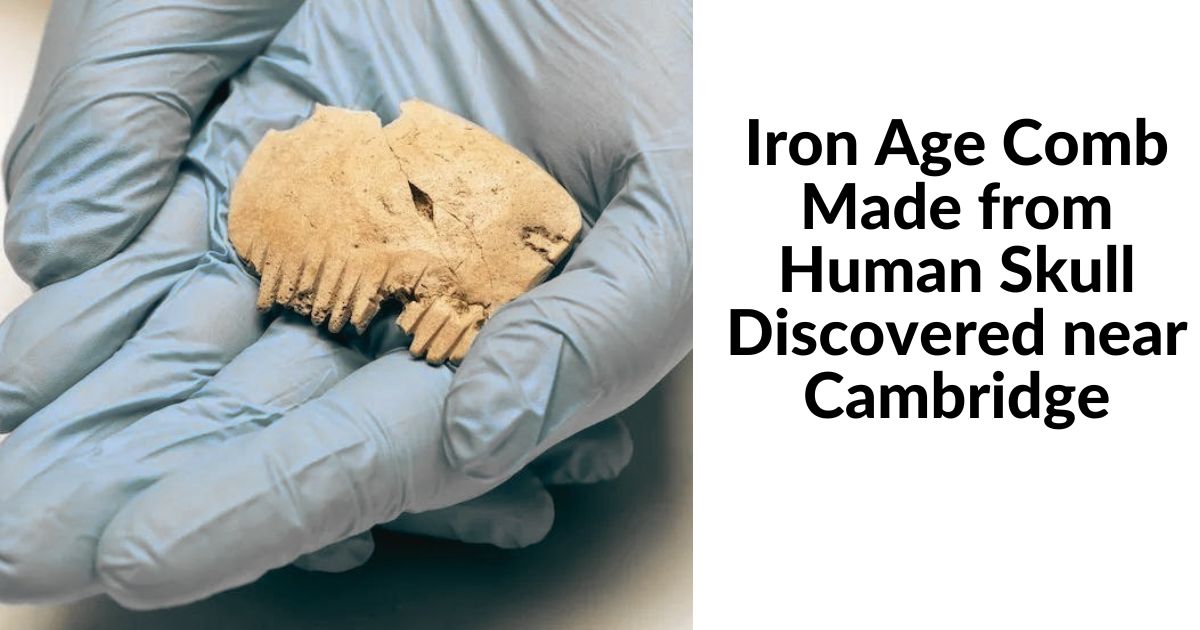Archaeologists in the UK have made a chilling discovery: a comb made from a human skull dating back to the Iron Age.
The comb, which is estimated to be around 2,300 years old, was found during an excavation near Cambridge.
The discovery is remarkable, as it provides a rare insight into the lives and beliefs of Iron Age people. The comb was likely used for ritualistic purposes, such as combing and styling hair before important events, and possibly even in funerary rites.
The comb is made from the skull of an adult male, which was carefully shaped and polished to create the teeth of the comb.
The skull was then decorated with a series of intricate designs, including a zigzag pattern and a series of circular markings. These designs are believed to have been created using a sharp tool, such as a flint or a bone needle.
The comb is a fascinating example of Iron Age craftsmanship and highlights the incredible skill and artistry of our ancient ancestors.
It is also a reminder of the dark and sometimes gruesome practices that were part of their daily lives.
The discovery of the comb has sparked a renewed interest in the Iron Age and has shed light on the rituals and beliefs of the people who lived during this time.
The comb is now on display at a local museum, where visitors can see it up close and learn more about its fascinating history.
Overall, the discovery of the Iron Age comb made from a human skull near Cambridge is an important reminder of the rich history and culture of the UK.
It is a fascinating glimpse into the lives of our ancient ancestors and a testament to their incredible skill and artistry.
The discovery of the Iron Age comb made from a human skull near Cambridge was made by a team of archaeologists from Cambridge Archaeological Unit, who were conducting an excavation in the area.
The excavation was part of a wider project investigating the history of the site, which is known to have been inhabited during the Iron Age and Roman periods.
The team of archaeologists discovered the comb while excavating a small pit, which was located in the vicinity of a larger Iron Age settlement.
The pit was found to contain a number of artifacts, including pottery, animal bones, and a small quantity of human remains. It was during the analysis of these remains that the team made the remarkable discovery of the comb made from a human skull.
Following the discovery, the team worked to carefully excavate and document the comb, using a range of specialist techniques and equipment.
This included 3D scanning, microscopic analysis, and x-ray imaging, which allowed the team to build up a detailed understanding of the object and its construction.
The discovery of the comb has since been reported in a number of academic publications and has attracted significant media attention. It is a testament to the skill and dedication of the archaeologists involved in the project, who continue to work tirelessly to uncover the hidden history of the UK.
The discovery of the Iron Age comb made from a human skull near Cambridge is interesting for a number of reasons. Here are a few of the most notable:
- The comb is made from a human skull: This is a very rare and unusual discovery, as it is extremely rare for a human skull to be used as a raw material for an object. The comb is believed to have been made from the skull of an adult male, which was carefully shaped and polished to create the teeth of the comb.
- The comb is around 2,300 years old: The comb is believed to date back to the Iron Age, which lasted from around 800 BC to the Roman invasion of Britain in AD 43. This means that the comb is around 2,300 years old, making it an incredibly rare and valuable artifact.
- The comb was likely used for ritualistic purposes: The comb is believed to have been used for ritualistic purposes, such as combing and styling hair before important events, and possibly even in funerary rites. This provides a rare insight into the beliefs and practices of Iron Age people.
- The comb highlights the skill and artistry of our ancient ancestors: The construction of the comb is incredibly skilled and intricate, with a series of intricate designs created using a sharp tool, such as a flint or a bone needle. This highlights the incredible skill and artistry of our ancient ancestors, who were able to create complex objects using only primitive tools.
- The discovery sheds light on the history of the area: The discovery of the comb was made during an excavation near Cambridge, which was part of a wider project investigating the history of the site. The comb provides important new insights into the lives and beliefs of the people who lived in the area during the Iron Age, and sheds new light on the history of the region.
During the excavation near Cambridge that led to the discovery of the Iron Age comb made from a human skull, a number of other artifacts were also discovered. These included pottery, animal bones, and a small quantity of human remains, in addition to the comb.
The discovery of these artifacts is significant, as it provides important new insights into the lives and beliefs of the people who lived in the area during the Iron Age.
The pottery and animal bones, for example, can provide information about the diet and lifestyle of these ancient people, while the human remains may provide clues about their burial practices and beliefs about the afterlife.
Overall, the discovery of these artifacts has helped to shed new light on the history of the region and its ancient inhabitants.

